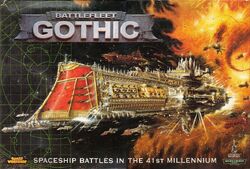
Battlefleet Gothic Boxed Set
Battlefleet Gothic is a tabletop miniatures game of starship combat based in Games Workshop's fictional Warhammer 40,000 universe, and is sold by Specialist Games.
Battlefleet Gothic is a starship combat game, and focuses around the incursion into the Gothic Sector of the Imperium of Man's Segmentum Obscurus of Chaos Warfleets under the command of the Warmaster of Chaos Abaddon the Despoiler, and the subsequent campaign by the Imperium to restore order, known as the Gothic War or the 12th Black Crusade.
Battlefleet Gothic is also the formation of the Imperial Navy based in the Gothic Sector after which the game is named and which is a major protagonist in much of the supporting fiction.
Introduction[]
Battlefleet Gothic is an extension to the Warhammer 40,000 universe, providing the ability for players to stage space battles between fleets of starfaring warships. Players select starships from a variety of fleets representative of the various Warhammer 40,000 races. The game as packaged includes rules and background for space fleets of the following factions:
- Imperial Navy (representing Battlefleet Gothic)
- Chaos (representing Abaddon and his Chaos allies' warfleets)
- Ork Freebooterz
- Eldar Corsairs
Subsequent additions and expansions published in numerous Games Workshop sources expanded the game to include fleets for:
- Space Marines
- Ork WAAAGH! fleets
- Craftworld Eldar
- Dark Eldar Raiders
- T'au Empire (including Demiurg, Nicassar and Kroot ships as well as T'au vessels)
- Tyranid Hive Fleets
- Necron Raiders
- Adeptus Mechanicus
- There are also numerous Imperial factions that have starships represented in Battlefleet Gothic such as the Inquisition, Adeptus Arbites, Adeptus Mechanicus, and Rogue Traders as well as numerous types of Imperial transports that are represented using current Battlefleet Gothic models as well as Forge World models and the old space fleet models.
Battlefleet Gothic starships are represented by 2-10 cm-long models. The rules and miniatures were originally available in Games Workshop stores, although reclassification as a "Specialist Game" means the rulebook is now available in PDF format from the official home page. Additionally, Forge World has produced numerous lines of miniatures for Battlefleet Gothic, ranging from models to replace ordnance markers to entirely new vessels.
Gameplay[]
Players take turns moving their ships and shooting, as well as undertaking more advanced maneouvres such as ramming, boarding, or disengaging. Each player may perform actions with all of his ships before the turn ends. The turns are divided into 4 phases, the Movement Phase, Shooting Phase, Ordnance Phase, and End Phase.
During the Movement Phase, the player can move his ships across the tabletop. Different ships move at different speeds, and turn at different rates. Smaller Escorts (frigates and destroyers) are typically the fastest ships in a fleet. Ships can also go into "Special Orders" during the Movement Phase. Special Orders allow ships to move/turn faster, reload their ordnance, or increase the efficiency of their firing, at the cost of being less able to perform other functions later in the turn (or in other turns); for example, if a ship uses a Special Order to increase power to the engines to turn, the ship's firepower is halved that turn.
During the Shooting Phase players fire their ships' weapons. Weapons are divided into two broad categories. Weapon Batteries represent massed broadsides that target an area of space, rather than being precision weapons. Lances represent more precise weapons consisting primarily of super-energised lasers, and target the enemy ships directly. Ships are protected from incoming fire by shields and armour. Enemy fire stopped by a ship's shields generate blast markers. Blast markers disrupt shooting, and slow down ships moving through them. They also temporarily bring down the shields of any ship in contact with them. Once shields are down, incoming shots impact against a ship's armour. Shooting can reduce a ship to a drifting, powerless hulk, or cause it to explode spectacularly. It can also cause critical damage, which covers a wide range of debilitating effects. Weapons can be taken offline, engines damaged, etc.
During the Ordnance Phase warships use weapons that move and fight independently of the vessel. This typically includes Torpedoes, Fighters, Bombers, and Assault Boats. Ordnance must be reloaded between each use by using a Special Order. Ordnance ignores shields, but can be stopped by point-defense turrets mounted on most ships. Ordnance can also be fired on by a ship's main weapons. Although fragile, most forms of Ordnance are very difficult to hit.
The End Phase is when damage control occurs. Each ship which is suffering from critical damage can attempt to repair itself. A variable number of blast markers are also removed during each End Phase.
Battlefleet Gothic: Armada[]
Games Workshop published the 'Battlefleet Gothic Annual' once a year after the game's release, with the exception of 2003, where the Annual was replaced by a 160-page supplement, Battlefleet Gothic: Armada. Among others, Armada introduced four new Imperial fleet rosters (Battlefleet Armageddon, Bastion Fleets, Battlefleet Cadia and the Reserve fleets of Segmentum Obscurus), as well as gathering the fleets previously mentioned into an official rulebook with updated fleet lists.
External Links[]
- Port Maw - An unofficial, community-driven fan site dedicated to Battlefleet Gothic.
- Cypra Probatii International - An unofficial, bilingual (English and Polish) article-orientated portal dedicated to Battlefleet Gothic.
Sources[]
- Battlefleet Gothic Rulebook by Andy Chambers
- Battlefleet Gothic - Armada (Video Game)

